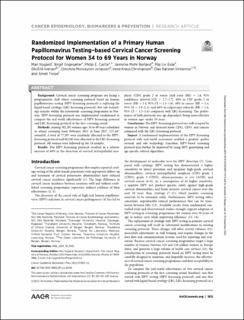| dc.contributor.author | Nygård, Mari | |
| dc.contributor.author | Engesæter, Birgit Øvstebø | |
| dc.contributor.author | Castle, Philip E. | |
| dc.contributor.author | Berland, Jannicke | |
| dc.contributor.author | Eide, Maj Liv | |
| dc.contributor.author | Iversen, Ole-Erik | |
| dc.contributor.author | Jonassen, Christine M | |
| dc.contributor.author | Christiansen, Irene Kraus | |
| dc.contributor.author | Vintermyr, Olav Karsten | |
| dc.contributor.author | Trope, Ameli | |
| dc.date.accessioned | 2022-09-30T11:36:59Z | |
| dc.date.available | 2022-09-30T11:36:59Z | |
| dc.date.created | 2022-09-17T17:05:35Z | |
| dc.date.issued | 2022 | |
| dc.identifier.issn | 1055-9965 | |
| dc.identifier.uri | https://hdl.handle.net/11250/3022883 | |
| dc.description.abstract | Background:
Cervical cancer screening programs are facing a programmatic shift where screening protocol based on human papillomavirus testing (HPV-Screening protocol) is replacing the liquid-based cytology (LBC-Screening protocol). For safe technology transfer within the nationwide screening programme in Norway, HPV-Screening protocol was implemented randomized to compare the real-world effectiveness of HPV-Screening protocol and LBC-Screening protocol at the first screening round.
Methods:
Among 302,295 women ages 34 to 69 years scheduled to attend screening from February 2015 to June 2017, 157,447 attended. A total of 77,207 were randomly allocated to the HPV-Screening protocol and 80,240 were allocated to the LBC-Screening protocol. All women were followed up for 18 months.
Results:
The HPV-Screening protocol resulted in a relative increase of 60% in the detection of cervical intraepithelial neoplasia (CIN) grade 2 or worse [risk ratio (RR) = 1.6, 95% confidence interval (CI) = 1.5–1.7], 40% in CIN grade 3 or worse (RR = 1.4, 95% CI = 1.3–1.6), 40% in cancer (RR = 1.4, 95% CI = 1.0–2.1), and 60% in colposcopy referrals (RR = 1.6, 95% CI = 1.5–1.6) compared with LBC-Screening. The performance of both protocols was age dependent, being more effective in women ages under 50 years.
Conclusions:
The HPV-Screening protocol was well accepted by women in Norway and detected more CIN2, CIN3, and cancers compared with the LBC-Screening protocol.
Impact:
A randomized implementation of the HPV-Screening protocol with real-world assessment enabled a gradual, quality assured, and safe technology transition. HPV-based screening protocol may further be improved by using HPV genotyping and age-specific referral algorithms. | en_US |
| dc.language.iso | eng | en_US |
| dc.publisher | AACR | en_US |
| dc.rights | Attribution-NonCommercial-NoDerivatives 4.0 Internasjonal | * |
| dc.rights.uri | http://creativecommons.org/licenses/by-nc-nd/4.0/deed.no | * |
| dc.title | Randomized implementation of a primary human papillomavirus testing-based cervical cancer screening protocol for women 34 to 69 years in Norway | en_US |
| dc.type | Journal article | en_US |
| dc.type | Peer reviewed | en_US |
| dc.description.version | publishedVersion | en_US |
| dc.rights.holder | Copyright 2022 The Author(s) | en_US |
| cristin.ispublished | true | |
| cristin.fulltext | original | |
| cristin.qualitycode | 1 | |
| dc.identifier.doi | 10.1158/1055-9965.EPI-22-0340 | |
| dc.identifier.cristin | 2052686 | |
| dc.source.journal | Cancer Epidemiology, Biomarkers and Prevention | en_US |
| dc.source.pagenumber | 1812-1822 | en_US |
| dc.identifier.citation | Cancer Epidemiology, Biomarkers and Prevention. 2022, 31 (9), 1812-1822. | en_US |
| dc.source.volume | 31 | en_US |
| dc.source.issue | 9 | en_US |

